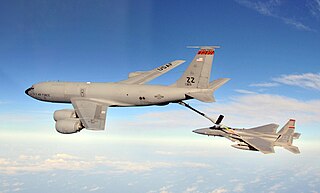
The Boeing KC-135 Stratotanker is an American military aerial refueling tanker aircraft that was developed from the Boeing 367-80 prototype, alongside the Boeing 707 airliner. It has a narrower fuselage and is shorter than the 707. Boeing gave the aircraft the internal designation of Model 717. The KC-135 was the United States Air Force (USAF)'s first jet-powered refueling tanker and replaced the KC-97 Stratofreighter. The KC-135 was initially tasked with refueling strategic bombers, but it was used extensively in the Vietnam War and later conflicts such as Operation Desert Storm to extend the range and endurance of US tactical fighters and bombers.
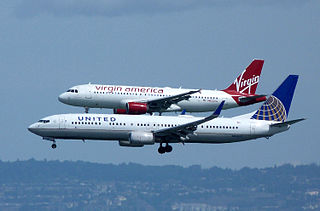
An airliner is a type of airplane for transporting passengers and air cargo. Such aircraft are most often operated by airlines. The modern and most common variant of the airliner is a long, tube shaped, and jet powered aircraft. The largest of them are wide-body jets which are also called twin-aisle because they generally have two separate aisles running from the front to the back of the passenger cabin. These are usually used for long-haul flights between airline hubs and major cities. A smaller, more common class of airliners is the narrow-body or single-aisle. These are generally used for short to medium-distance flights with fewer passengers than their wide-body counterparts.
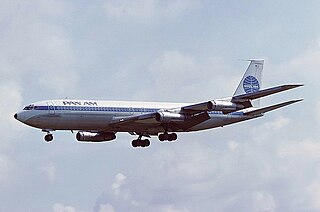
The Boeing 707 is an early American long-range narrow-body airliner, the first jetliner developed and produced by Boeing Commercial Airplanes. Developed from the Boeing 367-80 prototype first flown in 1954, the initial 707-120 first flew on December 20, 1957. Pan Am began regular 707 service on October 26, 1958. With versions produced until 1979, the 707 was a swept wing quadjet with podded engines. Its larger fuselage cross-section allowed six-abreast economy seating, retained in the later 720, 727, 737, and 757 models.

The Boeing 717 is an American five-abreast narrow-body airliner produced by Boeing Commercial Airplanes. The twin-engine airliner was developed for the 100-seat market and originally marketed by McDonnell Douglas in the early 1990s as the MD-95 until the company merged with Boeing in August 1997. It was a shortened derivative of McDonnell Douglas’ successful airliner, the MD-80, and part of the company’s broader DC-9 family. Capable of seating up to 134 passengers, the 717 has a design range of 2,060 nautical miles [nmi]. It is powered by two Rolls-Royce BR715 turbofan engines mounted at the rear of the fuselage.

The de Havilland DH.106 Comet is the world's first commercial jet airliner. Developed and manufactured by de Havilland in the United Kingdom, the Comet 1 prototype first flew in 1949. It features an aerodynamically clean design with four de Havilland Ghost turbojet engines buried in the wing roots, a pressurised cabin, and large windows. For the era, it offered a relatively quiet, comfortable passenger cabin and was commercially promising at its debut in 1952.

The Boeing E-6 Mercury is an airborne command post and communications relay based on the Boeing 707-300. The original E-6A manufactured by Boeing's defense division entered service with the United States Navy in July 1989, replacing the EC-130Q. This platform, now modified to the E-6B standard, conveys instructions from the National Command Authority to fleet ballistic missile submarines, a mission known as TACAMO.

The Douglas DC-8 is an early long-range narrow-body jetliner designed and produced by the American Douglas Aircraft Company. Work began in 1952 towards the United States Air Force's (USAF) requirement for a jet-powered aerial refueling tanker. After losing the USAF's tanker competition to the rival Boeing KC-135 Stratotanker in May 1954, Douglas announced in June 1955 its derived jetliner project marketed to civil operators. In October 1955, Pan Am made the first order along with the competing Boeing 707, and many other airlines soon followed. The first DC-8 was rolled out in Long Beach Airport on April 9, 1958, and flew for the first time on May 30. Following Federal Aviation Administration (FAA) certification in August 1959, the DC-8 entered service with Delta Air Lines on September 18.

A jet airliner or jetliner is an airliner powered by jet engines. Airliners usually have two or four jet engines; three-engined designs were popular in the 1970s but are less common today. Airliners are commonly classified as either the large wide-body aircraft, medium narrow-body aircraft and smaller regional jet.

The Boeing 377 Stratocruiser was a large long-range airliner developed from the C-97 Stratofreighter military transport, itself a derivative of the B-29 Superfortress. The Stratocruiser's first flight was on July 8, 1947. Its design was advanced for its day; its relatively innovative features included two passenger decks and a pressurized cabin. It could carry up to 100 passengers on the main deck plus 14 in the lower deck lounge; typical seating was for 63 or 84 passengers or 28 berthed and five seated passengers.

The Boeing C-135 Stratolifter is a transport aircraft derived from the prototype Boeing 367-80 jet airliner in the early 1950s. It has a narrower fuselage and is shorter than the 707. Boeing gave the aircraft the internal designation of Model 717. Since the first one was built in August 1956, the C-135 and its variants have been a fixture of the United States Air Force.

The Steven F. Udvar-Hazy Center, also called the Udvar-Hazy Center, is the Smithsonian National Air and Space Museum (NASM)'s annex at Dulles International Airport in the Chantilly area of Fairfax County, Virginia. It holds numerous exhibits, including the Space Shuttle Discovery, the Enola Gay, and the Boeing 367-80, the main prototype for the popular Boeing 707 airliner.

Alvin Melvin "Tex" Johnston was an American test pilot for Bell Aircraft and the Boeing Company.

Dutch roll is an aircraft motion consisting of an out-of-phase combination of "tail-wagging" (yaw) and rocking from side to side (roll). This yaw-roll coupling is one of the basic flight dynamic modes. This motion is normally well damped in most light aircraft, though some aircraft with well-damped Dutch roll modes can experience a degradation in damping as airspeed decreases and altitude increases. Dutch roll stability can be artificially increased by the installation of a yaw damper. Wings placed well above the center of gravity, sweepback and dihedral wings tend to increase the roll restoring force, and therefore increase the Dutch roll tendencies; this is why high-winged aircraft often are slightly anhedral, and transport-category swept-wing aircraft are equipped with yaw dampers. A similar phenomenon can happen in a trailer pulled by a car.
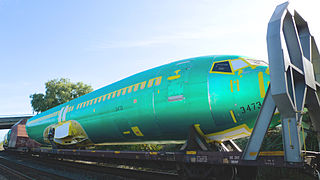
Cabin pressurization is a process in which conditioned air is pumped into the cabin of an aircraft or spacecraft in order to create a safe and comfortable environment for humans flying at high altitudes. For aircraft, this air is usually bled off from the gas turbine engines at the compressor stage, and for spacecraft, it is carried in high-pressure, often cryogenic, tanks. The air is cooled, humidified, and mixed with recirculated air by one or more environmental control systems before it is distributed to the cabin.

A narrow-body aircraft or single-aisle aircraft is an airliner arranged along a single aisle, permitting up to 6-abreast seating in a cabin less than 4 metres (13 ft) in width. In contrast, a wide-body aircraft is a larger airliner usually configured with multiple aisles and a fuselage diameter of more than 5 metres (16 ft), allowing at least seven-abreast seating and often more travel classes.
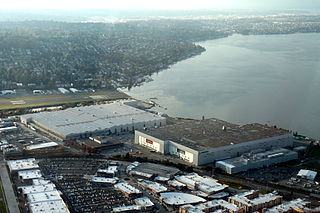
The Boeing Renton Factory is the Boeing Company's manufacturing facility for narrow-body commercial airliners, and their military derivatives. Current production includes the Boeing 737 MAX passenger airliner and the Boeing P-8 Poseidon military patrol aircraft. The factory covers 1,100,000 square feet (100,000 m2) of floor space. The factory lies adjacent to Renton Municipal Airport.
The Vickers-Armstrongs V-1000 was a proposed jet-powered cargo aircraft that was designed to meet a requirement issued by the British Ministry of Supply which sought a strategic transport for the Royal Air Force (RAF) to support its strategic bomber fleet, particularly the V-bombers. The design bears many similarities to the Vickers Valiant, one of the V-bombers, but also featured substantial changes. In addition to its military application, both the Ministry and Vickers also intended to use the same basic design as the VC7, a six-abreast trans-Atlantic jet airliner for British Overseas Airways Corporation (BOAC).
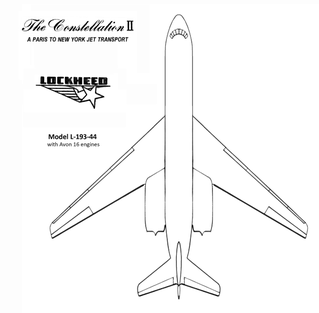
The Lockheed L-193 Constellation II was a jet airliner design concept, designed between 1949 and 1953 with a swept wing and engines mounted at the tail. An airliner and tanker version were developed. The latter, in an aerial refueling competition initiated by the United States Air Force (USAF), won and was preferred over the Boeing KC-135 Stratotanker. Since the competing Boeing aircraft was ready to fly first, examples were ordered as an interim measure. They performed well enough that the L-193 was never ordered as a tanker, and airliner plans were dropped soon after.

The Boeing C-137 Stratoliner is a retired VIP transport aircraft derived from the Boeing 707 jet airliner used by the United States Air Force. Other nations also bought both new and used 707s for military service, primarily as VIP or tanker transports. In addition, the 707 served as the basis for several specialized versions, such as the E-3 Sentry AWACS aircraft. The designation C-18 covers several later variants based on the 707-320B/C series. The C-137 should not be confused with the similar Boeing C-135 Stratolifter; although they share a common ancestor the two aircraft have different fuselages, among other structural differences.

The Boeing 720 was an American narrow-body airliner produced by Boeing Commercial Airplanes. Announced in July 1957 as a 707 derivative for shorter flights from shorter runways, the 720 first flew on November 23, 1959. Its type certificate was issued on June 30, 1960, and it entered service with United Airlines on July 5, 1960. A total of 154 Boeing 720s and 720Bs were built until 1967. As a derivative, the 720 had low development costs, allowing profitability despite few sales.
























